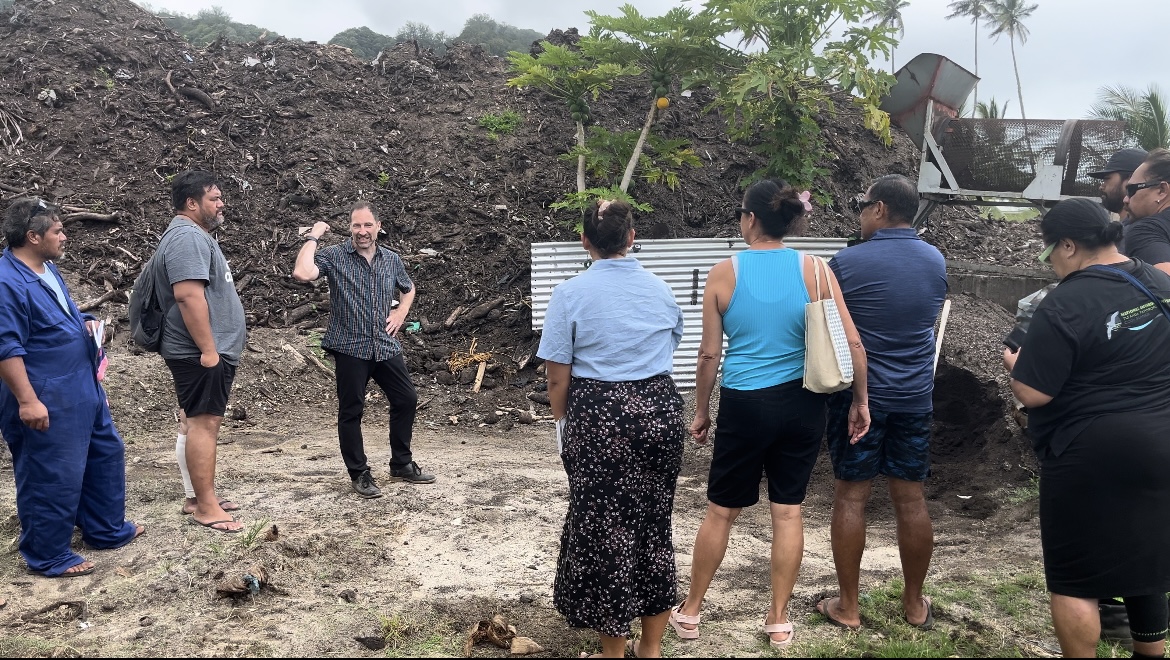Getting the dirt on composting
On Friday 6th December, Te Ipukarea Society took part in a hands-on composting workshop hosted at the Papaaroa Mission House by Chris Purchas, a New Zealand consultant. Chris specialises in environmental engineering. He has been helping the PacWastePlus Project, managed through the Pacific Regional Environment Programme (SPREP). He has been conducting various composting workshops across the Pacific. This Cook Islands event aimed to teach participants how to create and sustain a nutrient-rich compost using organic waste.
The event was organized by Waste Management Cook Islands, a division of Infrastructure Cook Islands, as an attempt to encourage local people, businesses and organizations to turn to easy sustainable living practices through composting. This was through introducing new composting techniques and information on how to get started in composting, as well as key features to be wary of for long term compost maintenance.
The event started with a brief introduction by each attendee before Chris led into the workshop with the areas that would be covered. After discussing how a compost was made, we made our way over to Teava Iro’s large composting site to connect the theory concepts with practice.
Compost is decomposed organic matter, where micro-organisms and other creatures such as worms and other decomposers consume green waste like fruit peels, leaves and vegetable scraps. A healthy compost requires biofuel for the microorganisms to maintain active consistency in breaking down materials. Ideally, there must be a balance in nitrogen-rich and carbon-rich materials, enough moisture and oxygen flow. As they consume the organic matter, their metabolic processes generate heat, causing the compost temperature to rise.
Managing the heat of a compost is crucial. We saw with Teava’s large pile that when the compost was turned there was steamy heat build-up in the middle that reached 60℃. This is perfect for the organisms and fungi to work; allowing it to get hotter would kill them. It would also attract other bacteria that generate methane and would be an overall fire hazard. On the other hand, if the compost is too cold, decomposition may stall. Chris pointed out that an easy solution to avoid this is simply turning the soil/compost to allow oxygen flow as well as watering if your pile is too hot or covering your pile if it's too cold.
The field activity highlighted the importance of air flow, water and food for a healthy compost. Oxygen or air flow is essential for microbes to breathe, it makes the composting process faster and more effective. it also reduces the chance of your pile producing a bad odour. Water provides the microbes a liquid to drink. If the compost is too dry, they would dehydrate and slow down production, and if too wet they would drown. Finally, like other organisms, food is required for sustenance and strength. It is equally important to have a balance of nitrogen-rich materials (e.g. fruit peels, vegetable scraps, grass clippings) and carbon-rich materials (e.g. dried leaves, cardboard and straw) for their consumption.
Another key concept in the workshop was understanding the effectiveness of your senses in comparison to buying expensive testing equipment. The compost site is divided into different sections based on the state of decomposition of the organic materials. At each section everyone was encouraged to feel and smell the compost to debunk the ‘fact’ that composts are stinky and slimy, when in reality a well-managed compost is not. This also allowed for participants to get a feel, smell and look at what an ideal compost should be like.
You need to look for biological indicators such as an abundance of fungi, which suggests that your compost is more carbon based. Using your nose, you can smell if it is just soil or if there are smelly pathogens. You can smell if there are contaminants within your compost and also take note of the moisture level. Touching the product, you are able to feel if it is in the light temperature range. Crumbly soil indicates a successful break-down of materials.
After a recess, everyone returned to the compost site for a further assessment of how the process of decomposition is activated and affected by various environmental and biological factors such as weather, temperature, water, air and food availability. As an activity, an excavator came along with different materials on it. Working together, everyone had to pick the suitable materials to build a compost pile, explaining their reasoning behind certain materials and the structural build to test their comprehension of the workshop topic.
The workshop concluded in the Mission Hall with a final reiteration of the topic. During a breakout discussion, participants were engaged with a hypothetical scenario designed to identify problems and explore potential solutions. This activity was to reinforce their understanding and ensure retention of all key concepts presented during the workshop, equipping them to implement sustainable composting practices that contribute to a healthier environment.

